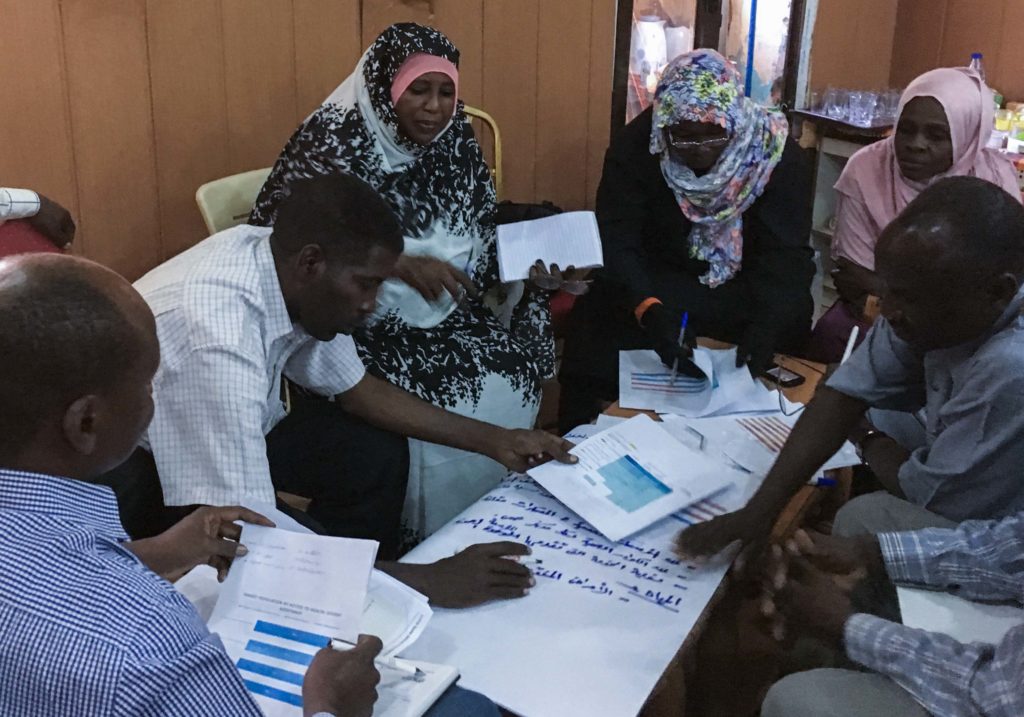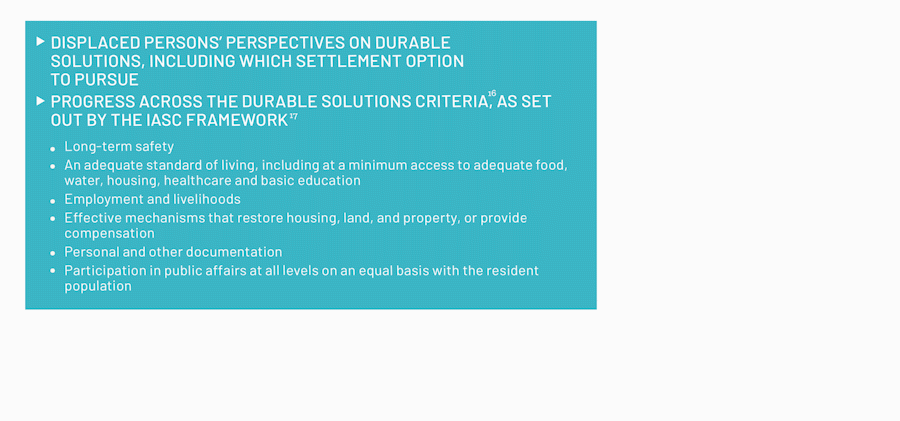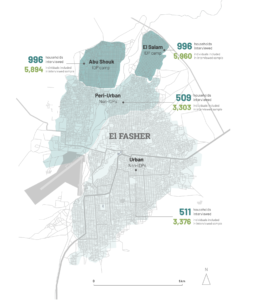As part of ongoing efforts towards durable solutions for Darfur’s internally displaced people (IDPs), the Government of Sudan, the United Nations Country Team and the wider international community represented by the Durable Solutions Working Group (including UNDP, IOM, UNHCR, WFP, UNICEF, OCHA, UN-Habitat, INGO Steering Committee and donors) initiated, in 2017, a collaborative durable solutions profiling process. Today, JIPS is thrilled to share the results of this process: an interactive story map providing you with a quick overview of key findings, and a comprehensive profiling report to dive deeper into the exercise (the profiling dataset will also be made available through the Humanitarian Data Centre for use beyond the exercise).
This profiling process marks an important step in the ongoing larger durable solutions process in Sudan: for the first time, all major stakeholders – the Government of Sudan, UN actors, the World Bank and the IDPs residing in Abu Shouk and El Salam camps – came together to jointly work on an agreed-upon evidence base that could inform policy design and long-term solutions planning. Owned and signed off by all parties, the profiling results and recommendations offer much-needed information on both displaced and non-displaced populations as well as the environment in which they reside. The exercise also allowed to pilot a durable solutions analysis approach, including data collection tools and methodologies, that can now inform subsequent durable solutions analysis exercises elsewhere in Sudan.
In this article, we will zoom in on the methodology used for the durable solutions profiling pilot and discuss some of the key lessons we learned from this experience.
15 years after conflict broke out in Darfur, in 2003, an estimated 1.86 million IDPs still remain in displacement, whilst 334,000 are living as refugees in neighbouring Chad. The majority of them live in camps that over the years have come to resemble permanent settlements. With the protracted displacement situation unsolved, finding durable solutions for IDPs and returning refugees is becoming ever more important.
“The type of data that is needed to inform durable solutions for IDPs has to be multi-purpose in thematic scope […] and [must provide] an understanding of a wide range of issues: the socio-economic conditions of displaced and non-displaced communities, the policy and legal environment, the availability of services and people’s access to them and, crucially, IDPs’ […] preferences for solutions.” – Sudan profiling report, page 15.
Beyond comprehensive data collection and analysis, the collaborative character of the durable solutions profiling process also “created a ‘space’ in-country that affords the various actors to work together to find a way forward”.
The voices of the IDPs were an essential part of the profiling process, with 200 sheiks representing the various ethnic groups, alongside women’s group and youth representatives taking part in various community engagement sessions at different stages of the process. This included workshops on how best to communicate with the camp communities, to select and validate survey indicators, and to help find enumerators representing the IDP community to conduct the data collection.
“What’s more important than having data, [is that] there should be active participation by communities affected by displacement. Communities should be involved in all steps of the study and should play a central role around the table.” – IDP representative.

The voices of the IDPs were an essential part of the profiling process
At JIPS we provided remote as well as on-site technical and coordination support throughout the profiling process. We supported profiling partners in reaching agreement on objectives and developing a methodology and tools as well as during the data analysis and reporting. At the beginning of 2018, and in order to provide a more direct support, one of JIPS’ profiling advisors was deployed to Sudan for a long-term secondment.
Focusing on the displacement situation in two IDP camps established in 2004, Abu Shouk and El Salam, the durable solutions profiling exercise piloted a systematic and principled approach. It adopted the IASC Framework on Durable Solutions for IDPs as analytical framework and operationalised it using the Interagency Durable Solutions Indicator Library and Analysis Guide.

Components of the durable solutions analysis in El Fasher
The exercise analysed displaced persons’ demographic profile, displacement history, current conditions, as well as perspectives on durable solutions, including desired settlement options, and placed a strong emphasis on understanding the thinking behind these preferences.
It furthermore looked at the progress IDP communities have made across the IASC durable solutions criteria, by combining a comparative population analysis (between IDPs in the camps and non-displaced populations in peri-urban and urban El Fasher) with that of a broader urban / macro environment (availability and use of urban plans, services and infrastructure). This helped to understand which challenges were shared by all population groups and which ones were specifically linked to the displacement situation.

Population map of IDPs in Abu Shouk camp and El Salam camps and • Non-displaced inhabitants of peri-urban and urban El Fasher
A sample of 3,000 households was collected using a stratified cluster sampling approach along four key strata:
IOM collected the data during the enumeration and the household survey with the support of various community representatives. Specifically, elders and youth representatives assisted in finding enumerators representing the IDP community. These teams of enumerators were tasked with administering the household questionnaires; the data was collected during May – July 2018.
The urban analysis in turn, was conducted with the technical oversight of UN-Habitat. The analysis examined urban plans for El Fasher including availability and use of land, and the availability of services and infrastructure. The urban analysis team worked directly with the State Ministry of Physical Planning and Public Utilities (SMPPPU) and the Housing Fund of North Dafur State.
Partners are currently in the process of evaluating in-depth the durable solutions profiling pilot in El Fasher, together with a project that ran in parallel and focused on community consultations to develop area-based action plans in Um Dukhun. Nevertheless, based on an initial evaluation of the profiling pilot, the comparative approach proved highly valuable in terms of informing area-based responses and local integration in protracted displacement situations.
The urban analysis, and specifically the combined analysis of access to and capacity of services, proves particularly valuable for local authorities to inform urban planning efforts. What is missing, however, is further consideration of the quality of these services, for a more comprehensive understanding of the city’s capacity to integrate displaced population groups.
Moving forward, the durable solutions profiling identifies six policy and programme considerations that can guide the next phase of the durable solutions process as laid out in the Durable Solutions in Practice Handbook, namely shaping of context-specific durable solutions targets:
The profiling findings also highlight other actionable priorities to progress towards solutions for IDPs, specifically with regards to access to services (including livelihoods, documentation, and security of tenure).
Moving forward, government authorities in North Darfur have stated their intention to integrate the IDPs in El Fasher, with the Abu Shouk camp becoming a new neighbourhood of El Fasher named Doha, whilst the El Salam camp is to be renamed as Al Shatti town.
—
Read more about the key findings through this interactive story map, and check out the comprehensive profiling report to dive deeper into the exercise.